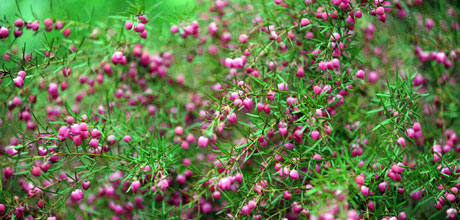Olê for Oil
This article was first published on 16 Nov 2011.

Boronia
Bravo for oil! No, not the thick black gold we use to transport our urban tanks… I’m thinking of the oil obtained from living plants.
Living plants containing oil play a huge role in our survival and pleasure of life. I take as examples my two essentially favourite components of life – food and fragrance.
Oil for Cooking
Today, we often use oils from sunflowers or peanuts though many plants are known for producing oils.
Lesser known for its oil producing capabilities is the camellia. The original oil-yielding plant of Southern China and Indo-China was Camellia oleifera. It was grown for centuries in plantations for the clear, thin oil extracted from its seeds. The camellia or ‘tea-oil’ was used for cooking and cosmetics.
In Japan, Camellia sasanqua was used and commonly cultivated for its oil producing seed rather than its flower.
Fragrant Oil in Another Family
Some plants contain fragrant oils to repel or attract attention. This is a shared characteristic of plants in another plant family, the Rutaceae or rue.
Scented Flowers and Foliage
Representing the Rutaceae family in the fragrant theme border at Dunedin Botanic Garden is Mexican orange blossom, Choisya ternata, Boronia and Nematolepis squamea, also known as Phebalium squameum.
Boronia heterophylla, from Western Australia is in full flower at present. This evergreen shrub has delicious heathery smelling foliage and the hot magenta pink flowers are also strongly fragrant.
The fragrant plants theme border at Dunedin Botanic Garden runs adjacent to Great King Street and can be accessed via the pedestrian entrance.
Marianne Groothuis is curator of the Camellia Collection and Theme Borders at Dunedin Botanic Garden.


